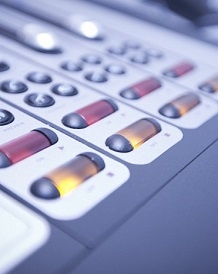Out of the darkness, flashing bars of red and blue, followed by the black, avian-like forms of two Typhoon fighter jets, emerge and glide side-long towards our plane.
One suddenly turns on its wing and dips below us, reappearing alongside our other flank, its sharp nose seeming to reach out for the nozzle of an outstretched hose which trails from the wings of our RAF Voyager jet like a jellyfish on a long tentacle, tossed about by savage currents.
Air-to-air refuelling at high speeds and in high winds looks, from my perspective less than 10m away, fiendishly hard.
It takes several minutes and several attempts before the pilot finally manages to latch the probe on the side of their jet on to the fuel hose nozzle and start to fill up, guzzling as much as four tonnes of fuel in one go.
But this is what they're trained for: highly technical manoeuvres at high speeds. The two RAF Typhoons on mission with us will refuel four times that night. It's a force multiplier. It means they'll be in the air and on patrol that much longer.
We're flying on a nighttime mission over Poland as part of NATO's Operation Eastern Sentry.
The RAF is supplying Typhoon fighter jets and refuelling capabilities to help patrol the skies and bolster NATO's eastern flank after Russia sent scores of drones into NATO territory on 10 September, the first time the alliance has had to deal with a coordinated and deliberate drone incursion into its airspace.
They were inexpensive Gerbera decoy drones, a way of testing NATO's defences and a warning from the Kremlin that Russia can do much worse in the way of drone warfare if European leaders continue to pour money and weapons into Ukraine.
Yes, the Typhoons can down any airborne threat, drones included, given they have Advanced Short Range Air-to-Air Missiles (ASRAAM) and a 27mm Mauser cannon.
Yes, that is a significant amount of firepower to use against what could end up being just an unarmed piece of plywood with a GPS tracker on it.
But this is an exercise in deterrence, to let Russia know that NATO is alert and ready, as European leaders gather to discuss how best to defend against drones beyond conventional air defence.
For that, they're employing Ukraine's hard-won expertise, developed beneath the misery of their drone-filled skies.
Read more:
Airport drone sightings - what we know
Putin issues defiant message
Russia's warning shot to NATO
Germany and Denmark are both reporting unidentified drone sightings over key installations, forcing them to close airspace including, temporarily, Copenhagen and Munich airports. Estonia escorted Russian MiG fighter jets from its airspace after a 12-minute incursion.
Russia is pushing boundaries, a warning shot to NATO as it deliberates support for Ukraine. Moscow, of course, denies all this.
For Vladimir Putin NATO is war-mongering. "We're closely monitoring the growing militarisation of Europe. Is this just talk, or is it time for us to take countermeasures?" he asked the audience at the annual Valdai meeting, a veiled threat if ever there was one.
But that is the status quo between Russia and NATO. Veiled threats and hybrid warfare, with drones a new weapon in Russia's arsenal.
NATO hopes to make Putin recognise limitations of his armed forces
As French President Emmanuel Macron said, NATO's best defence is "more unpredictability and more strategic ambiguity".
And images of what NATO is capable of, the mastery of its fighter jets, the coordinated armies within its command and their shared commitment to common defence, those are intended to make Russia's leader take stock and recognise the limitations of his exhausted and overstretched armed forces.
Whether they do or not, well - that is a completely different matter.

(c) Sky News 2025: Sky News joins NATO air patrol designed to deter Russia from pushing boundaries


 Manchester synagogue attack: Families pay tribute to 'kind and heroic' victims - as police arrest three more suspects
Manchester synagogue attack: Families pay tribute to 'kind and heroic' victims - as police arrest three more suspects
 Pro-Palestine marches to go ahead despite calls to cancel after Manchester synagogue terror attack
Pro-Palestine marches to go ahead despite calls to cancel after Manchester synagogue terror attack
 What we know about Manchester attacker Jihad al Shamie - as his family condemn 'heinous act'
What we know about Manchester attacker Jihad al Shamie - as his family condemn 'heinous act'
 Expert 'kept awake at night' over fear of deadly brain disease passed on in transfusions
Expert 'kept awake at night' over fear of deadly brain disease passed on in transfusions
